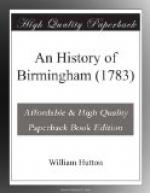Perhaps this is the only road in which money is of no use to the traveller; for upon this barren wild he can neither spend it, nor give it away.
He will perceive the Coldfield to be one vast bed of gravel, covered with a moderate depth of soil of eight or ten inches: During this journey of three miles, he will observe all the way, on each side, a number of pits, perhaps more than a thousand, out of which the Romans procured the gravel to form the road; none of them many yards from it. This great number of pits, tends to prove two points—That the country was full of timber, which they not choosing to fall, procured the gravel in the interstices; for the road is composed of nothing else—And, that a great number of people were employed in its formation: They would also, with the trees properly disposed, which the Romans must inevitably cut to procure a passage, form a barrier to the road.
This noble production was designed by a master, is every where straight, and executed with labour and judgement.
Here he perceives the date of his own conquest, and of his civilization. Thus the Romans humbled a ferocious people.
If he chooses to measure it he will find it exactly sixty feet wide, divided into three lands, resembling those in a ploughed field. The centre land thirty-six feet, and raised from one to three, according to the nature of the ground. The side lands, twelve each, and rising seldom more than one foot.
This centre land no doubt was appropriated for the march of the troops, and the small one, on each side, for the out-guards, who preserved their ranks, for fear of a surprize from the vigilant and angry Britons.
The Romans held these roads in great esteem, and were severe in their laws for their preservation.
This famous road is visible all the way, but in some parts greatly hurt, and in others, compleat as in the first day the Romans made it. Perhaps the inquisitive traveller may find here, the only monument in the whole island left us by the Romans, that time hath not injured.
The philosophical traveller may make some curious observations in the line of agriculture, yet in its infancy.
The only growth upon this wild, is gorse and ling: The vegetation upon the road and the adjacent lands, seem equal: The pits are all covered with a tolerable turf.
As this road has been made about 1720 years, and, as at the time of making, both that and the pits must have been surfaces of neat gravel; he will be led to examine, what degree of soil they have acquired in that long course of years, and by what means?
He well knows, that the surface of the earth is very far from being a fixed body: That there is a continual motion in every part, stone excepted: That the operations of the sun, the air, the frost, the dews, the winds, and the rain, produce a constant agitation, which changes the particles and the pores, tends to promote vegetation, and to increase the soil to a certain depth.




